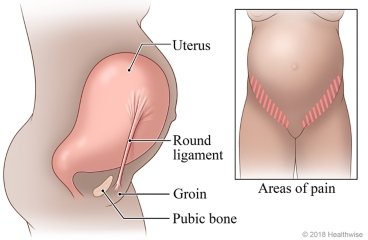Understanding Round Ligament Pain During Pregnancy & How Pelvic Physiotherapy Can Help
Amy Price PT, MSc PT, BSc Kin
Pelvic Health Physiotherpiist
Pregnancy is a time of many rapid physical changes to the body, and this can unfortunately result in different types of discomfort or pain. One common complaint among pregnant people is round ligament pain. Round ligament pain can be felt on one or both sides of the lower abdomen and radiate into the groin area. It can be sharp cramping pain or more of a dull ache. While round ligament pain is very common and a normal part of pregnancy, it’s important to understand its physiology, causes, and how pelvic floor physiotherapy and exercise can help manage it.
What are Round Ligaments?
The round ligaments are two bands of connective tissue that support the uterus. They run from the front of the uterus and attach to the pelvis on either side. These ligaments play a crucial role in holding the uterus in place as it grows and changes shape to accommodate a developing baby. As the pregnancy progresses, the round ligaments stretch and are placed under tension as they accommodate the growing uterus, which can lead to pain and discomfort.
Physiology and Causes of Round Ligament Pain
Round ligament pain typically occurs in the second trimester, although it can be experienced earlier depending how quickly the uterus and abdomen is expanding. The discomfort can be triggered by certain movements, such as standing up quickly, turning over in bed, or coughing. This pain is generally short-lived, but it can be intense when it happens.
Several factors contribute to round ligament pain during pregnancy. As the uterus grows, the stress on the ligaments increases. Additionally, the ligaments get less support from the musculature of the abdominal wall, contributing to more strain. Postural changes, including changes in pelvic positioning or tilt, can occur as the baby continues to grow, which can also put more strain on the ligaments that stabilize the uterus. Hormonal changes during pregnancy can also make the ligaments more susceptible to discomfort.
How Pelvic Floor Physiotherapy Can Help
While round ligament pain is usually a temporary and manageable condition, pelvic floor physiotherapy can play a key role in reducing discomfort and promoting long-term pelvic health.
1. Strengthening Core and Pelvic Floor Muscles: Pelvic floor physiotherapy can help strengthen the muscles of the pelvic floor and core. Strong pelvic floor and core muscles help support the growing uterus, reducing the strain on the round ligaments and alleviating discomfort
2. Manual Therapy and Soft Tissue Techniques: Physiotherapists are trained to use soft tissue techniques, such as massage and myofascial release, to reduce muscle tightness and tension in the pelvic region. This can help alleviate discomfort related to round ligament pain.
3. Breathing Techniques: Learning proper breathing techniques can make a significant difference in managing pain. A pelvic floor physiotherapist can teach relaxation strategies, such as diaphragmatic breathing and relaxation, to help ease the discomfort associated with round ligament pain.
4. Addressing Postural Issues: A pelvic floor physiotherapist can assess posture and alignment, and recommend techniques to improve body mechanics. Proper posture helps distribute the weight of the growing uterus evenly, reducing strain on the round ligaments and pelvic floor.
Round ligament pain is a common and temporary discomfort experienced by many people during pregnancy. While the pain can be alarming, it is usually not harmful to the pregnancy. Understanding the causes and the physiology behind round ligament pain can help you manage it better. Pelvic floor physiotherapy, along with targeted exercises, can be a valuable tool in reducing discomfort and supporting overall pelvic health during pregnancy. If you are experiencing round ligament pain, it’s a good idea to consult with a pelvic physiotherapist at Proactive Pelvic Health Centre, to develop a tailored plan that suits your individual needs.
Resources:
https://my.clevelandclinic.org/health/symptoms/21642-round-ligament-pain
Image: https://myhealth.alberta.ca/Health/aftercareinformation/pages/conditions.aspx? hwid=ace3318


